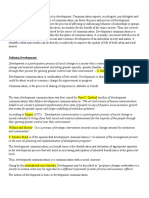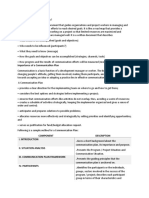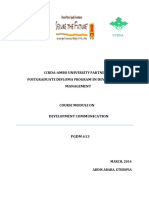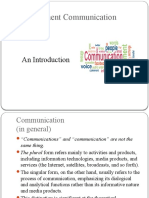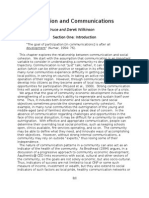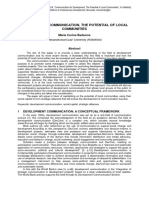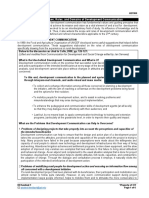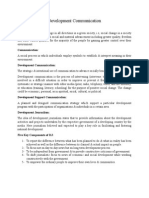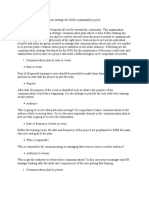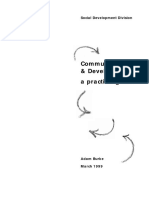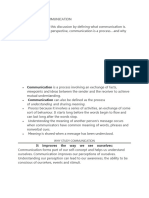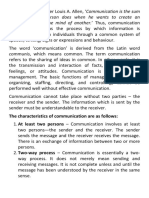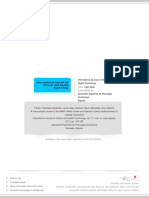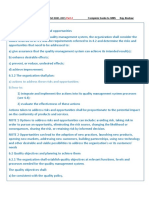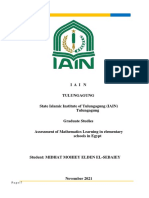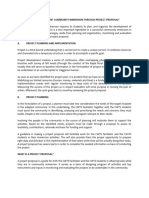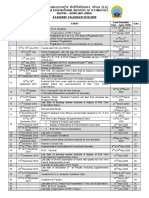Development Communication Planning
Development communication rests on the premise that successful development calls for the conscious and active participation of the intended beneficiaries at every stage of the development process; for in the final analysis, development cannot take place without changes in attitudes and behavior among the people concerned. To this end, Development Communication is the planned and systematic use of communication, through inter-personal channels, audio-visuals and mass media:
to collect and exchange information among all those concerned in the planning a development initiative, with the aim of reaching a consensus on the development problems being faced and the options for their solution. to mobilize people for development action, and to assist in solving problems and misunderstandings that may arise during development plan implementation. to enhance the pedagogical and communication skills of development agents (at all levels) so that they may dialogue more effectively with their audience. and last, but by no means least, to apply communication technology to training and extension programmes, particularly at the grassroots level, in order to improve their quality and impact.
The main features and steps of implementing communication activity are as follows: Research (community Need Assessment): No communication activities can be expected to succeed without a prior understanding of how the people to be affected by a project perceive their own problems and the development options being proposed, what they aspire to, how they obtain and exchange information, which media sources and interpersonal channels enjoy the most credibility, and so on. Community Need Assessment (CNA) process is based on the felt needs of the com m unity. It is not arbitrary but systematic and relevant to local situations. The message designed for Development Communication is not uniform to all audiences as in the top- down (or diffusion of innovation) approach. It is in accordance with the realistic information needs of the community. The approach is based on the peoples involvement and consultations with them for larger coordination, cooperation and better utilization of resources (human, organizational and technical). Community need assessment helps the development support communication provider in, a) Setting priorities. b) Identifying, segmenting and targeting a specific group. c) Leading to realistic estimation of services and matching the resources needed for the same. d) Develop realistic action plan/ communication plan for the development support providers that would be relevant to local situations.
�Community need assessment involves: 1) Need-based participatory planning. 2) Community involvement in assessment of their needs and planning, monitoring and evaluation. 3) Self-estimated goals by development support providers. 4) Good quality service. 5) Educating and providing technical organizational and management skills to the community. While assessing community needs of a locality, the (development support communication provider) should keep the following factors in mind: 1) 2) 3) 4) Physical and geographical conditions of the locality. Socio-economic status of the community. Cultural traits of the locality. Indigenous knowledge and technology (traditional technical skills of the community). 5) Available infrastructure (transportation, electricity, health and sanitation, etc.) 6) Existing communication network and mass media channels (their reach, access and relevance). Setting Objectives On the basis of need assessment, we can set one or more of the following communication objectives: a) Informational: Message exposure Message comprehension Message retention b) Attitudinal: Attitude formation Attitude reinforcement Attitude change c) Behavioral: Behavior formation Behavior reinforcement Behavior change The set objectives should be SMART. It stands for; Specific- What kind of change in which specific audience group you like to make. Measurable- The level of change can be measurable either in qualitative or quantitative terms.
�Appropriate- Communication programmes must show the intended audience a clear benefit from the services, ideas or other practices. By knowing and listening to your audience, you can position the programme to help meet an important unmet need of the intended audience segments. Realistic- Communication programmes must be properly implementable with your resources given or mobilized from different sources. Time bound- Communication programmes must indicate during what period particular activities to be implemented and intended behavior change will occur. The next step in the process is designing effective message. Message and Material Development For maximum impact, make your messags clear and simple. Avoid complexity. Focus on benefits and practical solutions that meet peoples needs. Use strong visual images. All these must be in accordance with the local language/ dialect, values and customs. Keep in mind the seven Cs for effective communication: credibility, clarity, content, context, channels of communication, consistency and continuity, and capabilities of the audiences. Message development being technical in nature, you can take help of local talents and also the grassroots development workers. After preliminary drafts of the messages, you are required to pretest the message with local groups and individual representatives of the intended audiences, to find out what works for them. Encourage audience participation. Give special attention to pictures or other no-verbal materials that might be easily understood. On the basis of findings and recommendations in pretesting, you need to make necessary revisions in message content. Revise any material that is not understood, remembered and relevant or controversial or offensive to the intended audiences. These revised materials then can be produced for communicating to the target audiences. Monitoring and Evaluation: Finally, Monitoring and evaluations are two important functions of the development communication programme which needs close scrutiny. Monitoring can be defined as the process of measuring, recording, collecting and analyzing data on actual implementation of the programme, so that any deviation from the planned operations are detected, diagnosed, for the causes of deviation is carried out and suitable corrective actions are taken. Evaluation is aimed at assessing whether desired results of a programme have been achieved and if not, how it should be redesigned. Monitoring is a process, which is done frequently during the implementation of the plan. It may be done by discreet observations, discussions, reviewing statistics and reports. The basic purpose of monitoring is to permit required changes, if they need to make the programme effective. Evaluation is the cumulative result of monitoring over a period of time. Evaluation is the assessment of the quality and quantity of the work turned out by an individual or an organization. There are two types of evaluation: Formative and Summative.
�Formative evaluation deals with making an assessment of the existing norms of an area or individual. The knowledge helps to redesign or reorganize an activity to suit the needs. While Summative evaluation is important for advancing our knowledge of what worked and what did not work in an activity or campaign. Such evaluation is useful in determining whether or particular approach was beneficial enough to be used again. The purpose of evaluation is to measure the process and the impact of a programme or activity against the objectives set in the statistic design in order to provide input to the design making. In order to conduct monitoring and evaluation study, you need to plan activities, campaigns or programmes that will require monitoring and evaluating. But to do this it is essential to know the existing knowledge, attitudes and practices of the community. To conduct knowledge, attitude and behavioral assessment, following rapid appraisal methods can be applied:
Observation, Focus group discussion, Group meetings, Interpersonal interaction with opinion leaders, Grassroots workers, Individuals in the community, Survey methods.
You need to keep in mind that communications programmes or activities pose a special problem for evaluation: First, communication is not an independent variable function, but usually form a part of other programme functions. Second, most communication activities have both, short-term and long-term effects. Third, communication may have intended or unintended effects. As communication programmes are usually in a context or the competition with other messages, it is possible; communication evaluation may need to identify unintended effects or impact.

